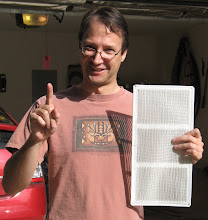But with the radiant barrier, very few of us understand how something reflective could possibly work from inside the attic. Sure, we understand that if we put silvery reflective stuff on the roof or at the very least painted the roof white we would reflect a good bit of the sun's energy back out into space, and these things are quite true. But, as it turns out, installing reflective barrier properly inside the attic itself works and works dramatically well, as my own experience demonstrated. It turns out that the effect of covering the inside of a non-shaded attic with radiant barrier foil is about the same as covering the entire thing with shade from a shade tree. In effect, the sunlight's energy gets reflected back out. While this is different from tree leaves in that the tree absorbs the energy to make chemicals it needs, rather than reflecting the energy back, the upshot is the same: the energy does not get into your attic. It also turns out that this is only the case if the foil barrier is installed with an air
Because of lack of intuitive understanding, a lot of folks lean towards additional insulation as the first improvement to make. But in hot climates such as ours in central Texas, the radiant barrier can be a good bit more effective, depending on the initial state of the house.
I have said it before, but it bears repeating: there are 3 physical ways that heat enters your home in the summer: radiation, convection, and conduction, and there is a solution for each of them. The absolute best way to keep that heat out of your house is probably to spend a little time and money on each of the 3 ways, rather than going all-in on a single solution. Thus, a radiant barrier to handle the radiation of heat, ventilation to utilize convection in your favor, and a little additional insulation to fight conduction might well do wonders for you. This approach actually tripled the efficiency of my own house; of course, your mileage may vary. Your house may be a lot less of a solar oven than mine was at the beginning.
So don't be afraid of that barrier, folks! It is affordable, it has no moving parts to break down, and it works!

